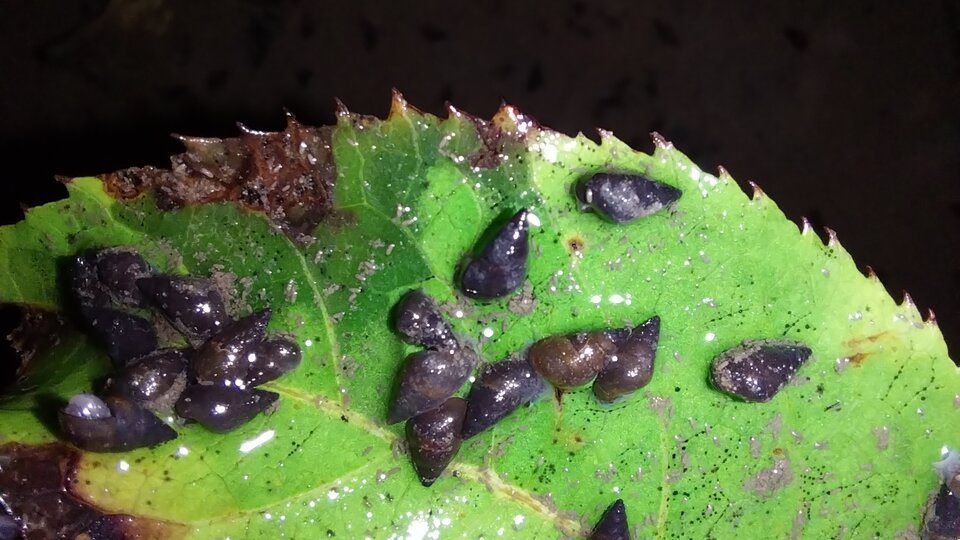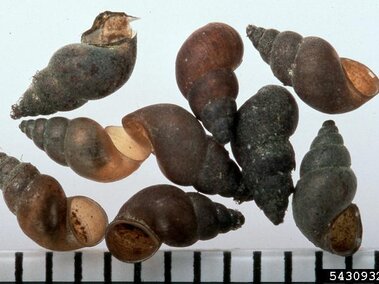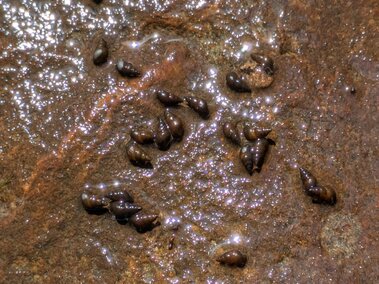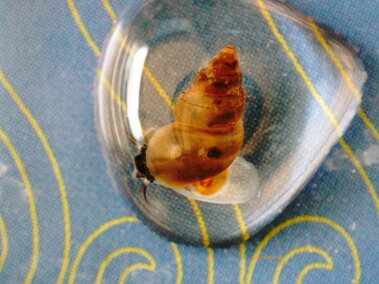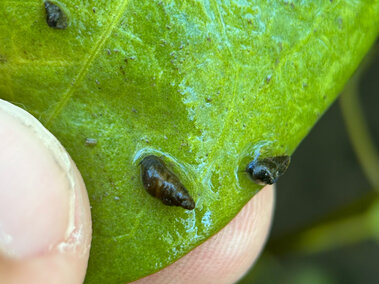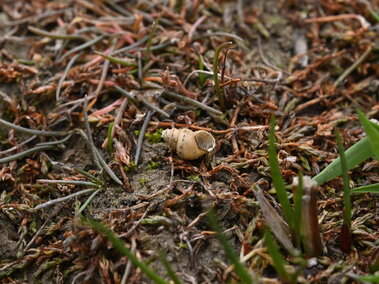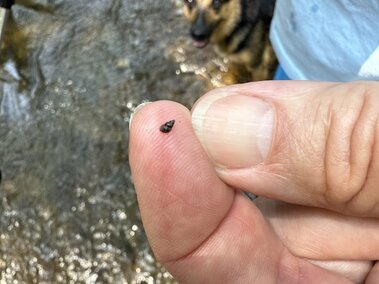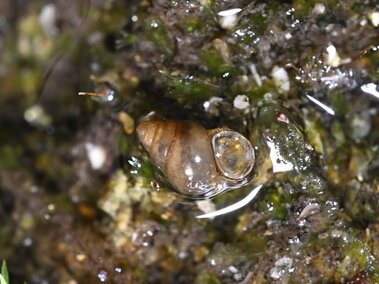General Information
Species Name: Potamopyrgus antipodarum
Also Known As: mudsnail, New Zealand mudsnail, New Zealand mud snail
Family: Hydrobiidae (Mud Snail)
Life Span: Up to 1 year
Life Cycle: Ovoviviparous (eggs develop and hatch inside the body) and parthenogenic (embryo develops from an unfertilized eggs) (i.e., needs no fertilization), Mudsnails are highly adaptable aquatic snails that can tolerate a broad range of aquatic conditions. A single female may produce an average of 230 offspring a year.
Origin: New Zealand
Injurious: No
Category 1: Potential Aquatic Invasive Species
Why Are They Invasive?
Mudsnails can form dense populations and may crowd out native grazers and snails and prevent colonization by other macroinvertebrates, like native insects, including sensitive species that are indicators of ecosystem health. They are very tolerant of poor water quality, a wide range of temperatures, transport on mats of algae, and can even pass through the guts of fish alive. Densities greater than 300,000 individuals per square meter have been observed in Montana, making mudsnails likely candidates as a biofouling nuisance at water intakes. They can also carry parasites that infect native snails and fish.
What Do They Look Like?
Mudsnails are small animals with a coiled spiral shell. They grow only one-eighth to one-fourth inches long and are grey to brown in color. The shell opening is on the right when the shell is pointed up. They have an operculum (”trapdoor”) covering the opening, which is missing when the snail is dead and the shell is empty.
Photos
Where Do They Live?
Mudsnails graze on lake and river bottom material. They are typically found in cold stream systems where densities can reach 100,000 to 700,000 individuals per square yard. They can occupy any shallow water (estimated less than 150 ft. [45.7 m]). They are tolerant of turbidity, siltation, and poor water quality, can reproduce in salinities up to 15 ppt, and can survive for short periods of time in salinities up to 35 ppt. Mudsnails can survive in water temperatures up to 93 °F, but do not to tolerate freezing temperatures. Mudsnails can also survive short periods of desiccation if in a cool, damp environment.
How Do They Spread?
Mudsnails were unintentionally introduced into the United States with imported rainbow trout in Idaho in the 1980s, as well as into the Great Lakes through the discharge of contaminated cargo ship ballast water. They easily attach to boots, waders, clothing, shoelaces, watercraft, aquatic vegetation, and gear, and can easily go unnoticed due to their very small size. As a result, they are commonly transported by unsuspecting anglers, boaters, other water recreationists, or even wildlife, including harvested fish. Mudsnails also disperse through floating freely or on algal mats, or by surviving passage through fish guts.
How Do I Control Them?
Contact the Nebraska Game and Parks Commission to determine appropriate control methods. To prevent their spread and introduction into your waterbodies:
CLEAN your watercraft, trailer, angling gear and other equipment. Remove all aquatic vegetation and animal species from your equipment.
DRAIN your watercraft at the ramp by removing the boat plug and draining all live wells and ballast tanks.
DRY your watercraft, trailer and other equipment for at least 7 days before visiting another waterbody.
DON'T DUMP BAIT. Dispose of bait by emptying bait buckets on dry land, away from waterbodies or in a trash receptacle. Moving a live organism from one waterbody to another is illegal, even if you are planning to use the organism as bait.
DON'T LET IT LOOSE. Do not release or transport exotic or non-native fish species to new ecosystems. It is unlawful to release any aquatic species into a waterbody other than the one from which it was harvested. Doing so can promote the spread of AIS.
What Should I Do If I See Them in Nebraska?
If you see mudsnails in Nebraska, you should report them to the Nebraska Game and Parks Commission's Aquatic Invasive Species (AIS) Program using their AIS Report Form. For guidance on what information to include in your report, check out our reporting tips.
References and More Information
California Department of Fish and Wildlife
Center for Invasive Species and Ecosystem Health
Smithsonian Environmental Research Center
Summary of Species Currently Listed as Injurious Wildlife under (18 U.S.C. 42) Lacey Act
Minnesota Department of Natural Resources
Nebraska Game and Parks Commission
Texas Invasive Species Institute
UC Riverside Center for Invasive Species Research
US Geological Survey Nonindigenous Aquatic Species
